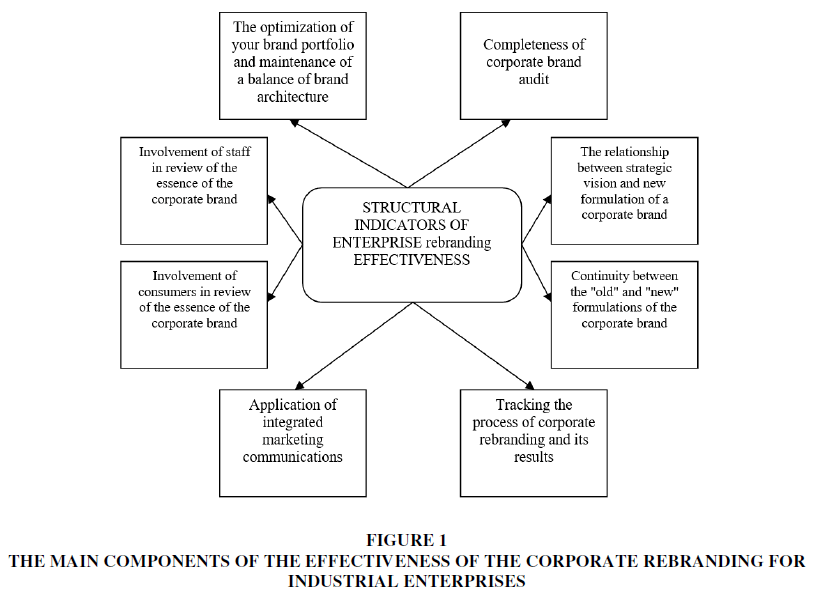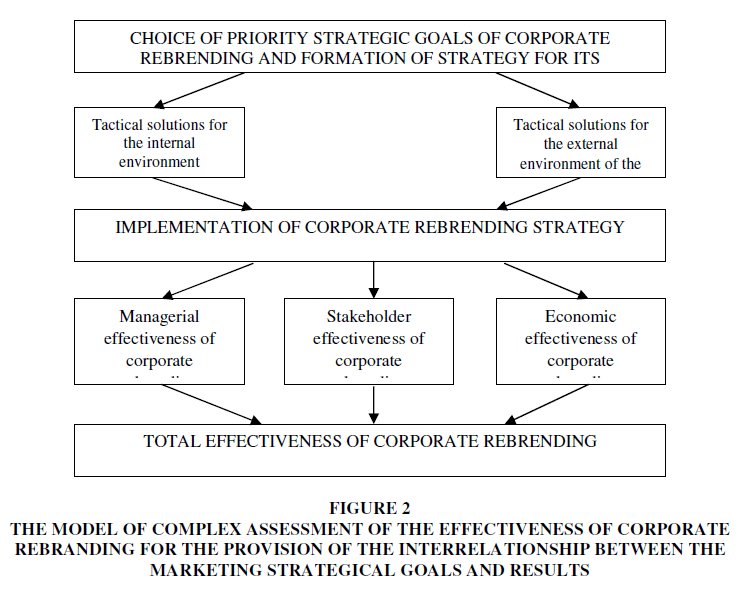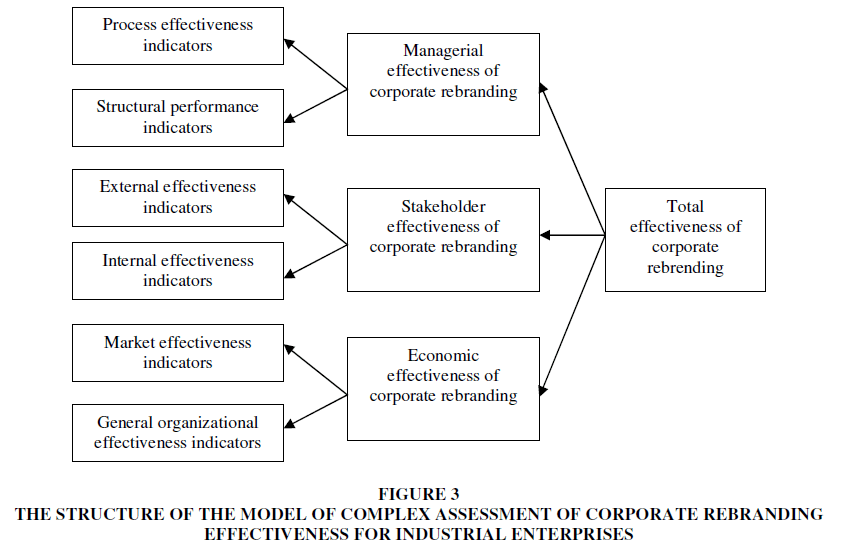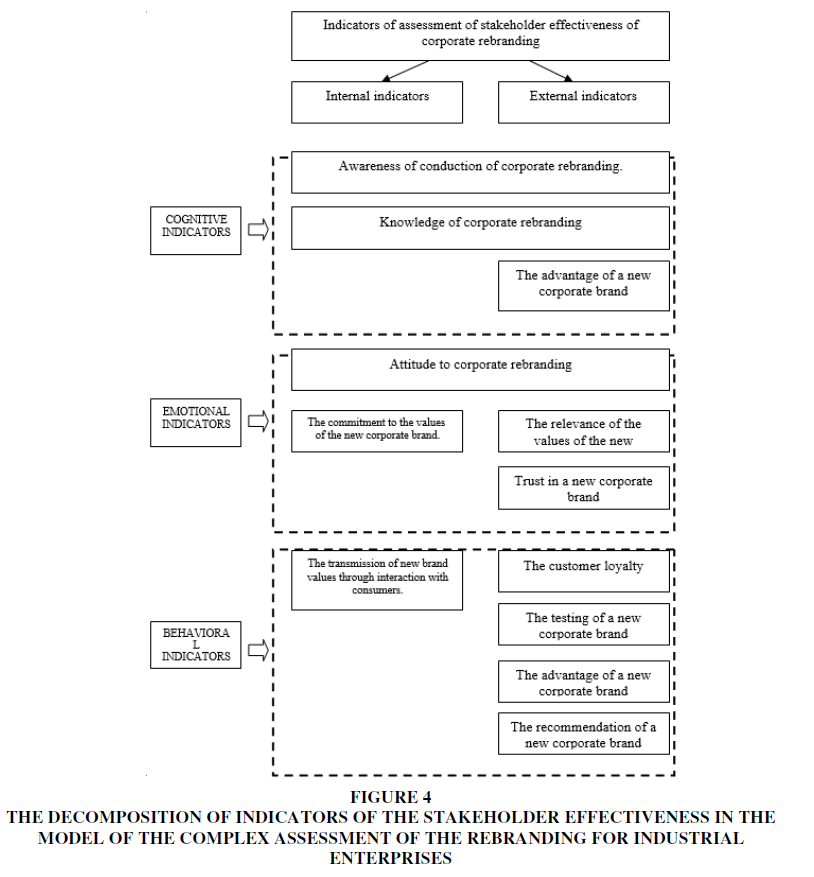Research Article: 2020 Vol: 24 Issue: 1S
Use of Rebranding in Marketing Sphere of International Entrepreneurship
Vyacheslav Makedon, Oles Honchar Dnipro National University, Ukraine
Hanna Zaikina, Ukrainian State Universiti of Railway Transport, Ukraine
Liudmyla Slusareva, University of the State Fiscal Service of Ukraine, Ukraine
Olena Shumkova, Sumy National Agrarian University, Ukraine
Olga Zhmaylova, Sumy National Agrarian University, Ukraine
Abstract
The paper determines the organizational and effective approached to the use of the rebranding technology in marketing sphere of international entrepreneurship. The main components of the effectiveness of the corporate rebranding for entrepreneurs were distinguished. The model of complex assessment of the effectiveness of corporate rebranding for the provision of the interrelationship between the marketing strategical goals and results was developed. The decomposition and systematization of indicators of the stakeholder effectiveness in the model of the complex assessment of the rebranding for entrepreneurs.
Keywords
International Entrepreneurship, Entrepreneur, Marketing Sphere, Rebranding Technology, Stakeholder Effectivess, Assessment Model, Marketing Strategy.
JEL Classifications
M5, Q2
Introduction
In the modern conditions of the world highly competitive market, the brand management in the environment of the industrial enterprises is more often considered as the guarantee of the creation of the stable competitive advantage that allows to achieve high market effectiveness and successfully implement the marketing strategy. In this aspect, the corporate brand became to be interpreted as the strategic non-tangible asset for industrial enterprises. The success of the implementation of the corporate branding depends on the ability to support relevant and attractive value offer of the brand in the long-term run, in other words, from the possibility to preserve its urgency in the conditions of the rapidly changed competitive environment. These factors determine urgency of this science study.
Methodology
Like any product, each brand has its own life cycle. At some point, the life cycle curve reaches its maturity and then the recession period begins. The brand recovery can be used to ensure brand survival (Charters, 2009); Jones (2010). Some brands may not be upgraded and therefore you need to understand whether your company brand falls into this category. In order to determine the brand's ability to change, it is necessary to find out the causes of existing brand problems, whether there are opportunities for development, overall customer relationship with the brand, whether the brand matches a dynamically developed market, and new trends that impede brand development (Brexendorf & Kernstock, 2007). The brand recovery can happen at the level of product, quality, consumer perception, area of use, manufacturer, customer relationship and so on. The need for rebranding strategies may arise where the brand has the potential but does not meet the requirements of this category of market. When an enterprise is the owner of a large portfolio of brands, it can succeed in consolidation. As Tevi (2013) points out, complete rebranding implies a change in brand values caused by the company's transition to a new level.
Literature Review
In the last twenty years we can observe the significant increase in the number of scientific papers devoted to the various aspects of the brand management of the industrial enterprises. The papers of the following authors are devoted to the issues of theoretical bases and specifics of the corporate brands: Aaker (2004); Chew (2009); DeChernatony & McDonal (2003); Johnson et al., (2006); Parkin (2010); Yin (2009). We can state that there is insufficient level of the working through the theory of the marketing management in the area of rebranding for industrial enterprises. This imbalance in the theory and practice ratio is very risky, since in such a situation the top management of international companies and structural units make management decisions blindly, without having a systematic and analytical substantiation at their disposal (Drobyazko et al. (2019 a,b,c). The purpose of the paper is to identify the essence of corporate rebranding, develop a model of comprehensive assessment of its effectiveness and form a system of indicators of its application in the activities of modern industrial enterprises.
Findings and Discussion
The corporate rebranding is a new and relatively unworked area in the practice of developing marketing strategies. In market conditions, industrial enterprises often use strategies that are aimed at modification of corporate brands (Bryman & Bell (2007). Corporate rebranding can be defined as the process of changing the name of a business unit or subsidiary, targeting and positioning it to develop a new corporate brand value and communicate new benefits to all stakeholders. We believe that branding performance can be viewed both broadly and narrowly (Balmer, 2010).
We can define the effectiveness of corporate rebranding as an aggregate indicator of achievement of goals of managerial, stakeholder and economic indicators that characterize the degree of new correspondence of corporate identity to corporate image and reputation. The systematicity and comprehensive nature of corporate rebranding necessitates consideration of the various components of its performance and the need to develop a set of efficiency indicators. We identify three central components of corporate rebranding effectiveness; 1. managerial, 2. stakeholder and 3. economic effectiveness.
According to Hatch & Schultz (2001), the existing approaches can be represented as three main families: 1) approaches to assess corporate rebranding effectiveness from a stakeholder perspective; 2) Approaches to assess corporate rebranding effectiveness from a company perspective; 3) Approaches based on multicriteria assessment of corporate rebranding effectiveness. The structural indicators characterize the level of performance of corporate rebranding management presented in Figure 1.
Figure 1 The Main Components of the Effectiveness of the Corporate Rebranding for Industrial Enterprises
Thus, the structural indicators of corporate rebranding performance are:
1. involvement of company management in the process of corporate rebranding;
2. competence (experience) of employees involved in corporate rebranding;
3. the level of interaction within the company in the process of corporate rebranding;
4. the effectiveness of business unit restructurization within corporate rebranding;
5. The effectiveness of interaction with the specialists involved and third-party organizations (advertising agencies, consultants, etc.).
These indicators include the growth of sales and the value of the company's shares (Metelenko et. al. 2019). The conceptualization of corporate rebranding from the point of view of the process approach allows us to consider this phenomenon as a system of interrelated processes, for which the formation of specific, but at the same time, interrelated effectiveness indicators is possible (Figure 2) (Martin & Burke, 2012).
Figure 2 The Model of Complex Assessment of the Effectiveness of Corporate Rebranding for the Provision of the Interrelationship Between the Marketing Strategical Goals and Results
The model of complex assessment of corporate rebranding effectiveness for industrial enterprises is presented in Figure 3.
Figure 3 The Structure of the Model of Complex Assessment of Corporate Rebranding Effectiveness for Industrial Enterprises
The resulting systematization of indicators that we consider necessary to include in the model of comprehensive assessment of corporate rebranding effectiveness is presented in Table 1 (Gregory (2007); Urde (2013)).
| Table 1 Systematization of Corporate Rebranding Effectiveness Indicators for Industrial Enterprises within Marketing Strategy | ||
| Group of indicators | A subgroup of indicators | Indicators of assessment of corporate rebranding effectiveness |
| Managerial effectiveness indicators | Structural indicators | - level of involvement of company management in the process of corporate rebranding; -format of interaction between departments in the process of implementation of corporate rebranding. |
| Process indicators | - completeness of corporate brand audit; - the relationship between strategic vision and new formulation of a corporate brand; -continuity between the former and the new formulation of branding; - monitoring of the process of corporate rebranding and its results -consistency of brand representation through integrated marketing communications channels. |
|
| Stakeholder effectiveness indicators | Internal indicators | 1.Cognitive: -awareness of corporate rebranding; - analysis of corporate rebranding data 2.Emotional: - attitude to corporate rebranding - commitment to the values of the new corporate brand 3.Behavioural: -transmission of new brand values through interaction with consumers. |
| External indicators | 4.Cognitive: -awareness of corporate rebranding; -understanding of the strategic importance of corporate rebranding; -organizational and economic benefits of a corporate brand. 5.Relevant: - thelevel of relevant value of the new corporate brand; - thelevel of commitment to the values of the new corporate brand; - the level of trust in a new corporate brand - degree of attitude to corporate rebranding 5.Behavioural: -customer loyalty; -testing (attitude from contact audiences) of a new corporate brand; - alist of benefits of a new corporate brand; - aset of recommendations for the development of a new corporate brand. |
|
| Economic effectiveness indicators | Market indicators | -market share; - return on brand investment (ROBI). -increase in sales of a new corporate brand. |
| All-organization indicators | - increase in brand sales; -profitability; -market share of the company. |
|
The proposed comprehensive corporate rebranding performance model reflects the relevance of the simulated output to the goals and objectives of the strategy.
Recommendations
The complexity of the proposed system allows to form the basis for the development of an individualized system of indicators (decomposition) of corporate rebranding performance, taking into account the specificity of certain industrial enterprises, considerable flexibility and adaptability to contextual conditions (Figure 4).
Figure 4 The Decomposition of Indicators of the Stakeholder Effectiveness in the model of the Complex Assessment Of the Rebranding for Industrial Enterprises
In general, stakeholder effectiveness indicators should characterize three components of perception: 1. cognitive (cognition), 2. emotional, 3. behavioural (behavioral reactions). The general indicators for groups of external and internal effectiveness of corporate rebranding include two cognitive indicators and one emotional.
Conclusion
In this scientific paper, we proposed to distinguish three common components of the effectiveness of rebranding: managerial, stakeholder and economic. The corporate effectiveness of corporate rebranding has been defined as the ability of the management system to achieve the target values of its effectiveness indicators. The stakeholder effectiveness was determined as the degree of achievement of the target values of industrial enterprise interaction with different stakeholder groups. The economic effectiveness is interpreted as the achievement of indicators that reflect the functioning of the corporate brand and the company as a whole in the market.
In addition, an analysis of previous studies on measuring corporate rebranding has identified some limitations in existing work related to the concentration on certain specific sets of indicators. Based on the conceptual delineation of the components of the rebranding, the authors identified six subgroups of effectiveness indicators: indicators of managerial (process and structural), stakeholder (internal and external) and economic (market and organizational) effectiveness of corporate rebranding. In the future, such research should determine the feasibility of application and evaluation of rebranding in different types of markets and development of an economic justification for such measures in the marketing strategies of industrial enterprises.
References
- Aaker, D. (2004). Leveraging the corporate brand. California Management Review, 46, 6-18.
- Balmer, J.M.T. (2010). Explicating corporate brands and their management: Reflections and directions from 1995. Journal of Brand Management, 18(3), 180-196.
- Brexendorf, T.O., & Kernstock, J. (2007). Corporate behaviour vs brand behaviour: Towards an integrated view? Journal of Brand Management, 15(1), 32-40.
- Burmann, C., & Zeplin, S. (2005). Building brand commitment: A behavioural approach to internal brand management. Journal of Brand Management, 12(4), 279-300.
- Brexendors, S. (2009). Does a brand have to be consistent? Journal of Product & Brand Management, 18(4), 284-291.
- Chew, C. (2009). Strategic positioning in voluntary and charitable organizations, New York, Routledge.
- DeChernatony, L., & McDonal, M. (2003). Creating powerful brands, Elsevier/Butterworth-Heinemann, Oxford.
- Drobyazko, S., Alieksieienko, I., Kobets, M., Kiselyova, E., & Lohvynenko, M. (2019). Transnationalisation and segment security of the international labor market. Journal of Security and Sustainability Issues, 9(2), XX.
- Drobyazko, S., Bondarevska, O., Klymenko, D., Pletenetska, S., & Pylypenko, O. (2019). Model for forming of optimal credit portfolio of commercial bank. Journal of Management Information and Decision Sciences, 22(4), 501-506.
- Drobyazko S., Makedon V., Zhuravlov D., Buglak Y., & Stetsenko V. (2019). Ethical, technological and patent aspects of technology blockchain distribution. Journal of Legal, Ethical and Regulatory Issues, 22(2S).
- Gregory, A. (2007). Involving stakeholders in developing corporate brands: The communication dimension. Journal of Marketing Management, 23(2), 59-73.
- Hatch, M.J., & Schultz, M. (2001). Are the strategic stars aligned for your corporate brand. Harvard Business Review, 79(2), 128-134.
- Jones, R.G.Jr. (2010). Putting privilege into practice through intersectional reflexivity: Ruminations, interventions, & possibilities. Reflections: Narratives of Professional Helping, 16(1), 122-125.
- Johnson, G., Scholes, K., & Whittington, R. (2006). Exploring corporate strategy (7th edn), prentice-hall, England.
- Martin, M.G., & Burke, R.J. (2012). Corporate reputation: Managing opportunities and threats, Gower Publishing, Ltd
- Metelenko, N.G., Kovalenko, O.V., Makedon, V., Merzhynskyi, Y.K., & Rudych, A.I. (2019). Infrastructure security of formation and development of sectoral corporate clusters. Journal of Security and Sustainability Issues, 9(1), 77-89.
- Parkin, D.A. (2010). Managing brand equity: Capitalizing on the value of brand name, New York, NY: The Free Press
- Tevi, A. (2013). Understanding corporate rebranding: An evolution theory perspective. International Journal of Marketing Studies, 5(3), 87-93.
- Urde, M. (2013). The corporate brand identity matrix. Journal of Brand Management, 20(9), 742-761.
- Yin, R.K. (2009). Case study research: Design and methods (4th ed.), Thousand Oaks, CA and London, Sage Publications.



